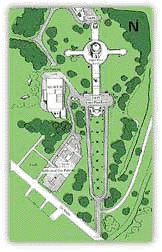| Material found on this page from McKinley Museum and National Memorial site. |  The Grounds |
| Material found on this page from McKinley Museum and National Memorial site. |  The Grounds |
President William McKinley spent most of his life in Canton, Ohio, with his wife, Ida, and their two daughters. He was elected Stark County prosecuiting attorniey and also served as the district's United States Representative and Governor of Ohio before his election as the 25th President of the United States in 1896.
In September of 1901, while serving his second term as president, McKinley was assassinated by Leon Czolgosz. The assassination occurred at the Pan American Exposition in Buffalo, New York, where McKinley was a guest speaker.
Plans for a memorial to McKinley were initated by newly inaugurated President Theodore Roosevelt. Ironically, the site chosen for the Memorial was actually selected by McKinley himself for a Stark County Soldiers' memorial. Funds were raised and construction of the memorial began in 1905. President Roosevelt came to Canton for the dedication ceremonies on September 30, 1907.
The design of the Memorial was created by Harold Van Buren Magonigle. Its neo-classic Greek design is a representation of the simplicity and diginity of McKinley's life. An areial view of the Memorial and grounds shows how the design represents both the cross of a martyr and the sword of a soldier president. The main steps and the circular drive form the upright portion of the cross and the side steps for the arms. The sword is formed by adding the Long Water* to the cross. The Long Water and the main steps form the blade of the sword and the side steps form the hilt. The mausoleum stands at the junction of the gurad and hilt of the sword or at the center of the cross.
Over two million bricks were used in the construction of the double-domed mausoleium. The interior dome measures 50 feet in diameter and is 75 feet high. The exterior dome is 75 feet in diameter and 95 feet high. Both the interior and exterior domes are made of pink Milford granite from Massachusetts.
Dominating the interior of the mausoleum is double sarcophagi made of Windsor green granite with a base of black Berlin granite. An inscription at the base of the dome is a quotation from McKinley's last speech in Buffalo. The McKinley children are entombed within the rear wall of the mausoleum.
One humdred and eight steps lead to the entrance of the mausoleum, arranged in fourt tiers conforming to the terraces on the hill. Two "block houses" at the base of the steps add balance to the design and provide service utility.
A statue of McKinley is located halfway up the steps. It was designed by Charles Henry Niehaus who created it from a phot of the president delivering his last speech. The base of the statue describes fund-raising efforts for the Memorial and the words of Benjamin Ide Wheeler, president of the University of California, conferring upon McKinley the degree of Doctor of Laws.
The Memorial has undergone an extensive restoration and enhancement process. Some of these projects include an access road to the Memorial, additional parking, and an elevator. A new domed shelter behind the Memorial, now adds grace and provides a shaded area for visitors to rest.
*In the 1950's the water was removed from the Long Water basin due to poor water circulation. The Long Water has been landscaped as a large grassy area for the visitors to enjoy.